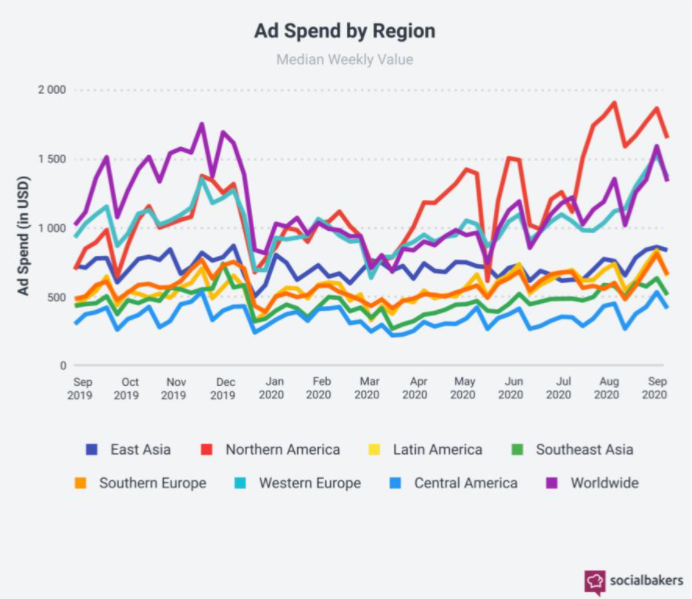
If 2020 has taught us anything, it’s that massive disruptions can happen overnight across industries, with customer communication responsibilities from marketing to care often falling to the social media marketing team. The trends we at Socialbakers have seen take shape this year — from increased usage of social messaging to recruiting niche influencers to help expand social reach — are likely to grow in the coming year as more and more customer interactions happen online.
Here are Socialbakers’ top five social media marketing predictions for 2021:
Social platforms will play a bigger role in CX programs
The pandemic has had a huge impact on the way consumers engage with brands. One area where this is most obvious is the rise in conversational messaging happening across social and chat applications. Customer conversations are moving away from traditional call centres and emails as brands shift to meet the customer on their preferred channels. Consumers are online and they expect brands to be where they are, responding to their questions and providing feedback in real-time.
As CMOs own more CX programs, we predict we’ll continue to see a rise in the number of brands adopting a hybrid model of human-agents and AI-powered social and website chatbots used to flag customer inquiries, respond to repetitive, frequently asked questions and escalate critical customer issues to agents — regardless of inquiry volume, time of day or language.
Facebook’s recent acquisition of Kustomer, a startup CRM platform, underscores just how important customer service features are to the SMBs that advertise on the social platform. By integrating more customer service tools and expanded customer experience capabilities, Facebook is positioning itself to own even more of the customer journey.
Social commerce will take a bigger bite of the eCommerce pie
Social commerce isn’t a new topic by any means. In fact, this time last year, Socialbakers predicted it would lift off in 2020, as it did for brands like Estee Lauder, but many brands still aren’t leveraging the full benefits social commerce has to offer. Now that social media platforms are building more features to manage everything from product discovery to in-app purchasing, post-purchase customer care and customer management, it’s a no-brainer for businesses to take advantage of the reach and infrastructure offered by social media platforms.
Socialbakers’ forecast around social commerce growth is directly connected to the accelerated digital transformation initiatives we’ve witnessed this year. (Shopify reported the number of new stores on its eCommerce platform jumped 62% between March and April compared to the six weeks prior.) The massive surges in digital programs by brands combined with in-app purchasing and shopping features launched by social platforms like Instagram and Pinterest translates to more purchases happening across the social landscape.
Not only are consumers more receptive to buying products via a brand’s social channel, social platforms are getting more savvy when it comes to designing tools that accelerate the path to purchase. In a time when more and more consumers are shopping online, businesses that build social commerce into the customer journey will safeguard their earning potential.
Micro-influencers will deliver more “bang for the buck” across social platforms
Earlier this year, Socialbakers published a State of Influencer Marketing report that examined how the Covid-19 pandemic affected the influencer industry during the first half of the year. Among the key findings, we saw a clear pivot toward influencers with smaller, more niche followings that could offer greater value to brands with tighter marketing budgets. Nano and micro influencers emerged as high-value resources, bringing high impact without the high-dollar price tag of macro and mega influencers.
Socialbakers’ influencer marketing report backed up an Econsultancy survey that found nearly 61% of 18- to 34-year-olds say digital influencers have swayed their decision-making at some point. Socialbakers’ own data showed more than 60% of brand-influencer collaborations on social in 2020 were happening with influencers that had less than 50,000 followers.
Brands are paying attention to the power of niche influencers: Hanes’ enlisted multiple influencers to help amplify its #MaskAround campaign this year, an effort that used the hashtag #MaskAround to encourage more people to wear masks and help prevent the spread of COVID-19. The US clothing brand turned to niche influencers on TikTok and Instagram to extend its reach among younger consumers whose opinions are more likely to be informed by social media personalities.
Social ad spend will continue to climb throughout 2021
Socialbakers’ ad spend reports for Q3 2020 showed that savvy brands were doubling down on their Facebook and Instagram investments, demonstrating a healthy trust in campaign performance as social media advertisers planned for the end of the year. During Q3, Socialbakers saw ad spend up by as much as 61% over Q2. We account these major lifts in ad spend to brands gaining an elevated confidence in social ad campaigns with consumers spending more time on their social feeds and more money online. Socialbakers expects this trend will continue into 2021.

Despite the disruptions and turbulent events caused by Covid-19 throughout 2020, social media ad spend rose sharply in Q3, reaching pre-pandemic levels. These jumps in ad spend were led by increased investments in eCommerce ads. Cost-per-clicks (CPCs) were up as well, with worldwide CPCs up by 42.4% in Q3 compared to the end of June, 2020.
The pandemic has accelerated online shopping, which in turn will continue to drive ad spend across social networks even as we head toward post-pandemic conditions.
The responsibility to reduce misinformation across social platforms will fall not only to social sites, but also governments and regulators
In light of the surge in misinformation campaigns connected to the 2020 election cycle and false news related to Covid-19, social platforms will continue to devote their time and efforts to reduce the spread of misinformation in order to maintain consumer trust in social networks. But the question going forward is: what new efforts will take shape to help reduce widespread misinformation campaigns plaguing social platforms?
In order to keep platforms clean and safe, there will need to be a shared responsibility between the platforms, governments and regulators, and the users on the platforms. We believe, for this to happen, governments will need to collaborate with social platforms to find a happy medium.
As I wrote earlier this year in a column for The Drum, Socialbakers works with the biggest brands in the world and understands the value of social media advertising in terms of finding new audiences and engaging with existing customers. Social media marketing has a positive impact on businesses in countless ways, but no brand wants that engagement at the cost of brand reputation, customer loyalty or worse.
“Brands want to be sure that they are investing their ad budgets on safe and trustworthy platforms, which are free from harm and toxicity,” I wrote in the column. If social platforms are unable to ensure safe environments for their users, the responsibility will fall to outside forces that can enact policies designed to eliminate toxic environments plagued with misinformation.
Photo by Karsten Winegeart on Unsplash

Interested in hearing leading global brands discuss subjects like this in person?
Find out more about Digital Marketing World Forum (#DMWF) Europe, London, North America, and Singapore.






